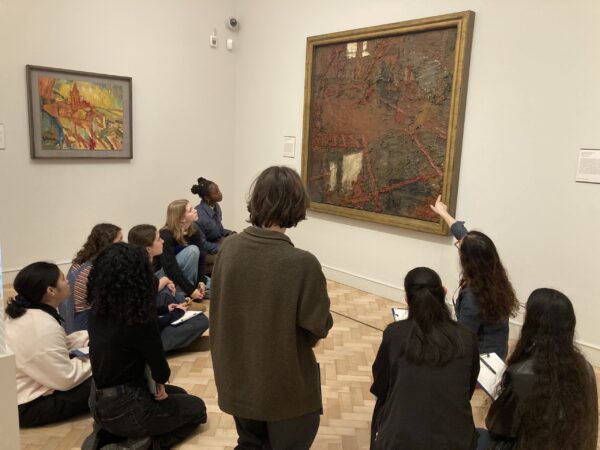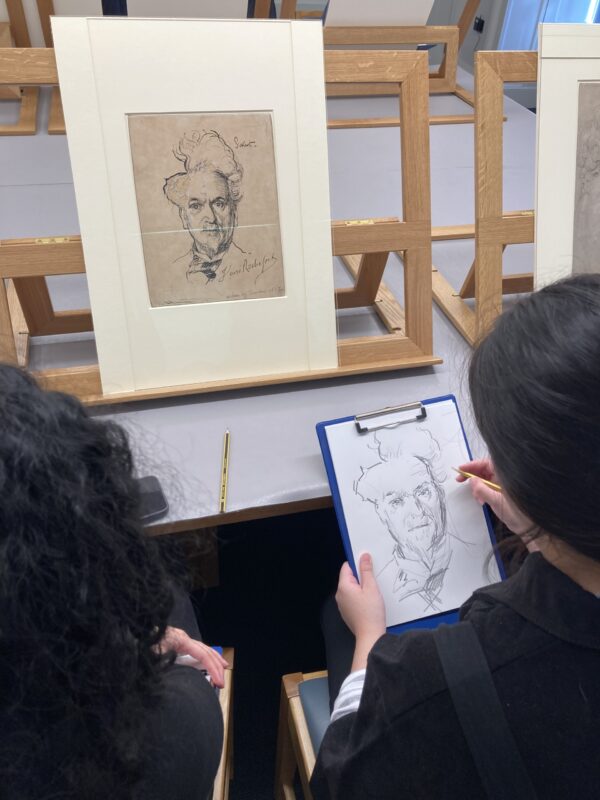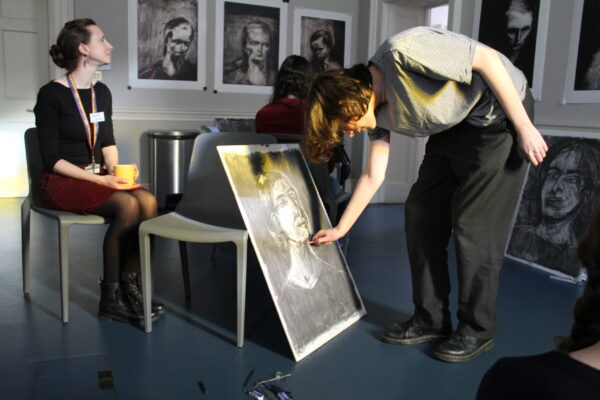
FOCUS: Frank Auerbach. The Charcoal Heads
Devised by Courtauld Educator Tanya Harris.
Download the PDF: Frank Auerbach. The Charcoal Heads.
Introduction
This resource invites you to look closely, discuss and experiment with drawing inspired by artworks in The Griffin Catalyst Exhibition: Frank Auerbach. The Charcoal Heads which you can see in a virtual tour here. In the tour you can see how the exhibition was displayed in the gallery as well as being able to zoom in to see remarkable detail, including tears in the paper
where the artist has patched it multiple times.
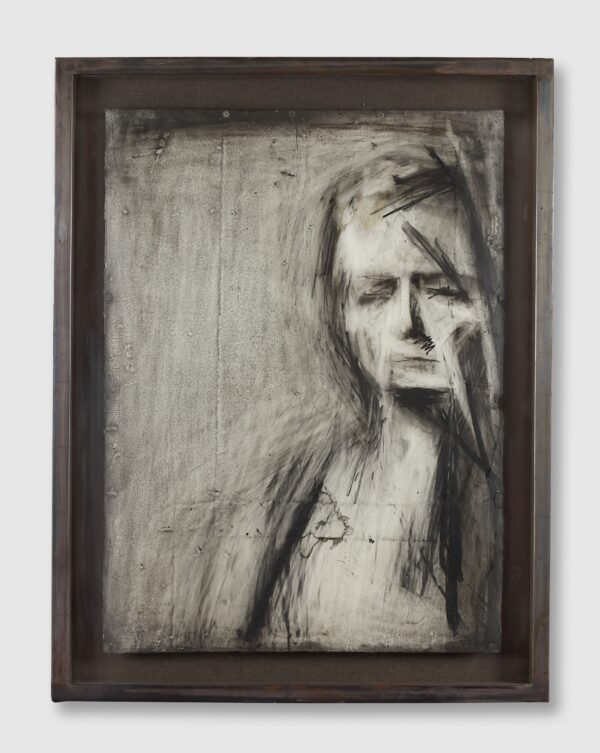

About the exhibition
The Griffin Catalyst Exhibition: Frank Auerbach. The Charcoal Heads focuses on a series of large-scale portrait drawings created by Frank Auerbach (born 1931) during his early years as a young artist in post-war London.
Auerbach spent months on each drawing, working and reworking them during numerous sessions with his sitter. The marks of this prolonged and vigorous process of creation are evident in the finished drawings which are richly textured and layered.
Auerbach’s heads emerge from the darkness of the charcoal as vital and alive, having come through a lengthy period of struggle – the image repeatedly created and destroyed. The character of the drawings speaks profoundly of their time as people were remaking their lives after the destructions and upending of war.
This exhibition is the first time Auerbach’s post-war drawings, made in the 1950s and early 1960s, have been brought together as a comprehensive group. They are shown together with a selection of paintings he made of the same sitters; for him, painting and drawing have always been deeply entwined.
Frank Auerbach and his sitters
Frank Auerbach was born in Berlin in 1931, to German-Jewish parents, and was sent to England when he was seven. He has few memories of living in Germany but remembers being given a paintbox for a birthday and the thrill of using his brush to put colour onto paper. He later learned his parents had been killed in Auschwitz in 1943. He has said, when interviewed, that he doesn’t look back or brood on the past as he has never wanted it to dominate his life.
Auerbach arrived in London in 1947 and whilst waiting to start at St Martin’s Art College took evening classes in life drawing led by David Bomberg at Borough Polytechnic. Bomberg encouraged him to use charcoal as an expressive drawing medium which led to Auerbach’s lifelong commitment to charcoal experimentation which we see in this exhibition.
Stella West aka E.O.W.
Stella West was Auerbach’s partner and would sit for him three nights a week. She would sit on a chair in her bedroom whilst he knelt on the floor with his drawing board propped up on a wooden chair
Leon Kossoff
Artist Leon Kossoff was Auerbach’s close friend who he met at St Martin’s Art College. Both Auerbach and Kossoff wanted to work with a model over long periods of time and spent days on end taking it in turns to sit for each other.
Helen Gillespie
Stella West asked her friend Helen Gillespie if she would sit for Auerbach. He wanted to challenge himself to draw someone he didn’t know well, rather than a close friend or partner.
Gerda Boehm
Gerda Boehm was Auerbach’s only relative in England when he arrived at
the age of seven. She lived in London and started sitting for him in 1960-61.
Julia Wolstenholme
Frank Auerbach met Julia Wolstenholme when they were students at the Royal College of Art. Wolstenholme admired the drawings he was making and asked to buy
one, Auerbach presented her with a drawing as a gift. They were married in 1958, shortly before their son Jacob Auerbach was born, but separated two years later. They reunited in 1976 and around that time Julia began sitting for him again which she did until shortly before her death in 2024.
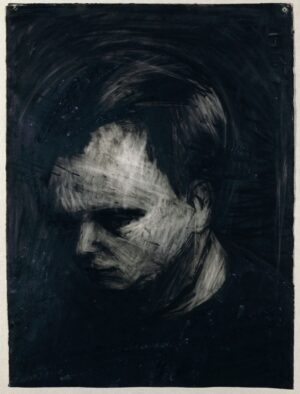
Introduction to Auerbach’s approach
This portrait of Leon Kossoff was made at a time when London was emerging from the destruction of war and we can draw parallels with the downcast pose and the way the head emerges out of darkness into light.
- What words would you use to describe the mood of the drawing?
Kossoff served in Europe in the Royal Fusiliers, attached to the 2nd Battalion Jewish Brigade, from 1945 to 1948 and Auerbach was a refugee from Nazi Germany.
- How does knowing about the context of when an artwork was made and something about the artist’s life affect how we read it?
- How do you think it affects the way an artist approaches their work?
Kossoff’s head is seen from above and takes up a large area of the paper. Concentrating on the head and shoulders rather than full body meant a stronger focus. Auerbach’s use of charcoal, chalk and eraser creates extremes of light and shade, making us aware of the skull beneath.
- How does the portrait make you feel? Which areas draw your attention?
Auerbach spent many months working on his drawings, rubbing away and restarting before something emerged that he felt was hard won but worth the effort. He doesn’t hide the damage, mending but keeping the scars is important to him.
- How does the broken paper make you feel?
- How would you feel if someone drew you for two hours then rubbed it all out?
Art Activities
The following activities ask you to look closely at a number of Auerbach’s artworks. Use
the tour to look at them in detail and make comparisons with other works. We hope they
inspire you to work with a depth of focus, seeking to portray the humanity of your sitter.
Auerbach spent many days and months on each drawing he created but you can work
within the time constraints you have and still learn from his process of drawing and mark
making. All activities have a suggested duration, if possible return to your work with your
sitter at a later date, remove what you find problematic and redo those parts until you are
satisfied with the outcome.
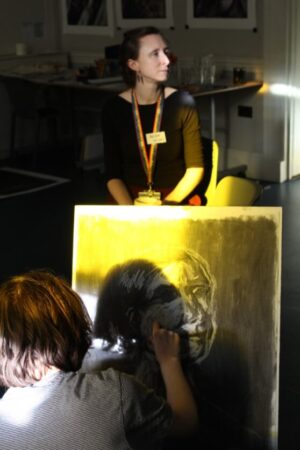
Classroom layout
Try rearranging your classroom tables to create a different space dynamic. Provide a chair for each sitter, or, if working with one sitter, position students so they can clearly see their face. Students could either draw whilst sitting on the floor, leaning their drawing board against the chair (as Auerbach would when drawing Stella West) or they could sit on a chair.
Use easels if available, drawing boards, or foam board/mount board as a lightweight alternative.
Drawing Materials
- Cartridge paper or watercolour paper,
- 200gsm – 300gsm if available*
- Charcoal sticks and compressed charcoal
- Plastic erasers
- White chalk
- Red, blue or bright pink chalk
- Mirrors for self-portraits
- A3 carbon paper sheets
- 4B Pencils
*Frank Auerbach stuck two 200gsm pages together, so if one sheet ripped there was another paper behind. For his Charcoal Heads he used Imperial Size paper: 56 cm x 76 cm.
Lighting
If you can control the lighting in your classroom turn off the main lights.
Try closing off part of the natural light with curtains/ blinds to direct the light source in consultation with the students.
If working in darkness or at night use directional light, with an electrical single source light.
Brief to the sitter
Ask your sitter to choose a position they can stay in comfortably whilst you draw them. Invite your sitter to choose a focal point in the space to look towards. Ask them to relax their eyes and their gaze as staring is tiring.
Position
Sit opposite the sitter in a position you can remain in comfortably whilst retaining your point of view. You may wish to sit closer to your sitter than at first you feel comfortable with to look closely and capture their head’s poise, character and expression.
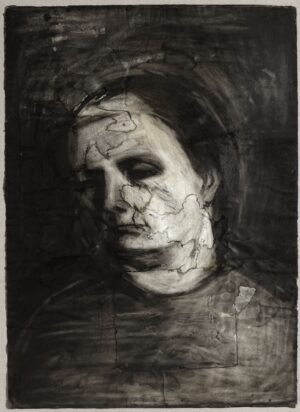
Activity 1: Drawing from shadow into light
Duration: 1 hour
Work in pairs taking it in turns to be artist and sitter, swapping every fifteen minutes.
Cover the whole paper sheet with charcoal, rubbing it in until the sheet is dark grey. Working from shadow into light, focus on the sculptural mass of their head, using a rubber to remove areas of charcoal where the light sculpts their head and the space. Focus on their facial expression and thoughtfulness. Using a thin willow charcoal stick, draw back into the areas you have rubbed out, defining the facial features, eye sockets, shadows below the nose, their facial structure and neck.
Keep the background simple, you do not need details of the person’s clothing. Add shadows back in if necessary and define light around the head. Try to capture the sculptural quality of their skull hidden beneath their hair and face.
- How does it feel to sit for a friend? How does it feel to draw a friend? Which do you prefer?
- How would you continue if you had two hours to make the portrait, what outcome are you striving for?
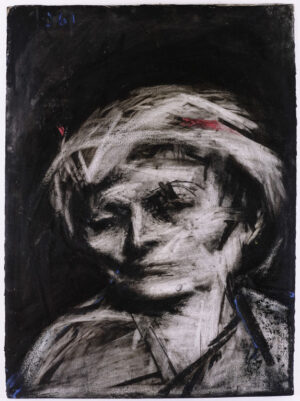
Activity 2: Two drawings from different angles
Duration: 1 hour
Auerbach’s sitters avoid eye contact. How does this affect how we see them?
Draw your sitter in thought looking past you downwards to your left.
Then draw your sitter in thought looking past you downwards to your right. Cover the whole paper sheet with willow charcoal.
Using compressed charcoal, draw in the deep shadows and define them with dynamic marks in the direction of their bone structure.
Draw with a plastic eraser where the light hits the angles of their face and head. Use white chalk to add highlights.
When you are ready bravely and thoughtfully apply energetic streaks of colour using blue, red or pink chalk on top of your drawing to define and add energy.
If your paper starts losing the top surface, enjoy the uncertainty
- When you are the sitter what are you thinking about?
- How do you stay focussed?
- When you are drawing what are you thinking about?
- What made you choose where to add colour?

Activity 3: Self-portrait
Duration: 45 minutes
Look closely at this self-portrait Auerbach made over many months using a mirror. Although he missed the energy of working with a sitter he wanted to challenge himself by making a self-portrait which made him focus inwardly.
- How does the energy in this self-portrait differ from his portraits in the exhibition?
- There are many patches on the paper, what conclusions can you draw from this?
- What feels different when drawing yourself rather than a sitter?
During the pandemic Auerbach was restricted by lockdown from working with his regular sitters so returned to self-portraiture which he continues to this day.
- How do you think you would feel looking back at a drawing you had made of yourself over fifty years ago?
Draw using a mirror, looking back at yourself. If you want to look away in your portrait, you need two mirrors so you can draw your reflection from the second mirror.
As you draw, stop occasionally to touch your head and feel your facial bone structure, remind yourself of the substance of what you are drawing and the life it contains.

Extension Activities
Activity 4: Experiment with pencil, carbon paper and layering
In this print, Frank Auerbach depicts his close friend, the artist Lucian Freud, as if in mid-conversation. The etching was printed from four plates in black and grey inks. The dense network of lines creates an impression of the sitter’s vigour while at the same time giving volume and form to his head and neck.
This etching can be viewed on request by making an appointment to visit The Courtauld’s Prints and Drawings Study Room which holds approximately 7,000 drawings and watercolours, and 26,000 prints ranging from the Renaissance to the present day, including works by Dürer, Michelangelo, Rembrandt, Turner and Cézanne.
School groups are welcome to visit.
Look closely at this print
- How is it different to the drawings and paintings in the exhibition?
Art Materials
- A3 carbon paper sheets (or A4 if easier to source)
- Cartridge paper
- 4B Pencils
- Coloured chalk
- Masking tape
Layer a carbon copy sheet between two pieces of paper and tape them onto a drawing board or table.
Drawing on the top sheet use dynamic lines and press heavily with your pencil onto the paper so your marks go through the carbon to the paper below.Explore Auerbach’s technique by building up layers of mark making.
Ask your sitter to move their face slightly then redraw on top of your original drawing with different marks.
Use the blunt end of your pencil to draw onto the top sheet to create an invisible drawing and a visible tonal drawing on the paper below.
You might choose to add marks of colour to your drawings.
When you have finished, you will have a pencil drawing on paper and a carbon drawing with a softer tonal quality underneath on the second sheet of paper. Compare the two.
- How does the layering of the lines and the carbon affect the tone and surface of the two drawings?
- How could you add to the layers?
- How does this process compare with the surface of Auerbach’s etching?
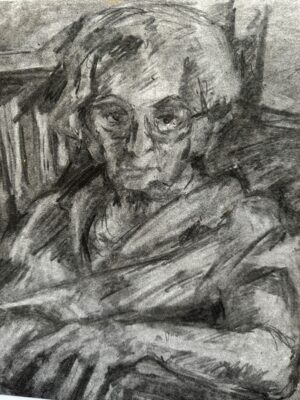
Activity 5: Create a portrait of someone you know and respect
Duration: 2 hours
Location: Your home or a relative’s home.
- Auerbach only draws or paints sitters he knows, and mostly he knows them very well. How does this affect how you look at his artworks?
Invite someone you are close to, to sit for a portrait.
Develop a rapport with your sitter and put them at ease.
Ask your sitter to choose a comfortable position and focal direction, relaxing their eyes to soften their gaze.
Ask them thoughtful questions about their life experiences or to share their opinions on a particular subject they care about
- What have you learnt about your sitter?
- How did they feel about your drawing?
If possible arrange to return and draw them again.
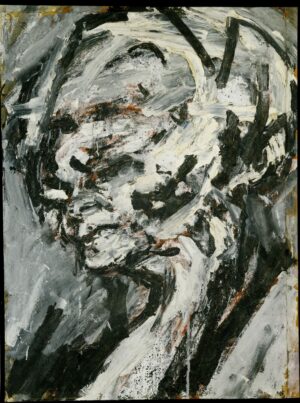
Activity 6: Moving from drawing into monochrome painting
Duration: 1 hour – repeat weekly until happy with your outcome.
Art Materials
- Canvas lined paper or watercolour paper
- Black acrylic paint
- White acrylic paint
- Paintbrushes of different thicknesses
- Water pot
Auerbach did not abandon painting when he started his charcoal heads, he would reach a point when he found the marks of drawing limiting and would return to the different opportunities paint provided. Making stand alone works in both mediums created a momentum for his work which has continued throughout his career.
- Look closely at the portrait of Gerda Boehm. How would you describe the sitter to someone?
This portrait began as a charcoal drawing which he worked on for months before becoming frustrated, choosing to finish quickly by painting with oils over the drawing.
- How would you describe the brushstrokes?
Prepare your paper or canvas paper by painting a warm orange-red ground across the background. Do this in a previous lesson so it has time to dry. Or you could choose one of your previous charcoal drawings to work over.
Look closely and regularly at your sitter.
Keep your arms and wrists flexible as you make marks in paint, focusing on the skull bone structure and the expression of the sitter.
Draw with your paintbrushes, using black and dark greys to define the shadows and white paint and pale grey for the highlights. Auerbach’s use of paint has sometimes been described as almost like a sculptural relief, experiment with how you might achieve a similar effect.
Research Frank Auerbach at The Courtauld
There are a number of works by Auerbach in The Courtauld Collection not currently on display which you can view online.
Study for Oxford Street Building Site
Figure study for Oxford Street Building Site
Study for Shell Building Site – Workmen under Hungerford Bridge
Sketch of Shell Building site (recto/front)
Sketch of Shell Building site (verso/back)
Figure study for Oxford Street Building Site






